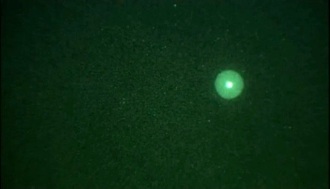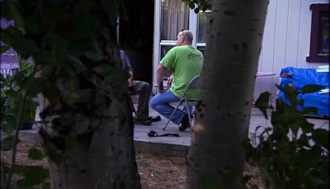Paranormal State Illustrated


Paranormal State Illustrated

Taking a close look at what you see and hear on a “Real Life. Drama.” TV series.
According to James Gilliland, this is an alien UFO during “power-up.” I say it has all the characteristics of an Iridium (satellite) flare.
FIRST CONTACT: UFO “Power-up” IS AN IRIDIUM FLARE
James Gilliland flashes a laser pointer at what is portrayed as an extraterrestrial UFO, and it supposedly makes itself visible as the UFO “powers-up,” as a means to say “hello.” The “power-up” is a brief increase in brightness, which lasts only seconds before the object appears dim- as it was before it flared.
The Paranormal Research Society (PRS), Paranormal State, and James Gilliland portray the flare as if it happened by an extraterrestrial UFO. The episode includes witnesses who describe what they believe they saw, with James flashing a laser pointer so it looks like the object in the sky brightens in response to the laser light.
But don’t be fooled. The UFO “power-up” shows all the characteristics of an Iridium satellite flare which is caused by sunlight, from below the horizon, reflected off one of three Main Mission Antennas (MMA). Each antenna is basically a shiny, highly reflective panel. Since Iridium satellite flares are predictable even seven days in advance (on the heavens-above.com Web site), James Gilliland or just about anyone, could learn the date, time, location in the sky, and how bright an Iridium flare will be for a particular location.
The satellites produce flare on their own because of the materials and methods used in their design and construction. Iridium flares are not caused by any paranormal event, they are not an extraterrestrial UFO, and they will flare whether or not James Gilliland flashes a laser at them.
First published: 03 August 2009
Updated: 25 January 2012
Written by: Ernie Marsh
Towards the beginning of the episode, we are shown witness testimony that alludes to the effect that various people have seen an extraterrestrial UFO “power-up.” Here are three examples of “witness” interviews.
WITNESS INTERVIEWS
3:43 PM
Caption as it appeared before the following three screenshots.
Screenshot 1, from Paranormal State “First Contact”
Appears at approximately 4 minutes 39 seconds.
Captioning as it appeared in the episode.
WHY I BELIEVE THIS AND OTHER UFO “POWER-UP” PORTRAYALS ARE IRIDIUM FLARES:
I called Dennis di Cicco, who is an astrophotographer, and Senior Editor for Sky and Telescope Magazine for his professional opinion about the brightening objects. Although Dennis did not see the Paranormal State, “First Contact” episode, I described the situation where an object is seen moving across the night sky, where it gets continually brighter for a short period of time (lasting just seconds), then dims back down to being barely visible, like it was before it brightened.
NOTE: you might want to see what an Iridium satellite looks like, to be able to visualize how a flare can happen. Look on the Smithsonian National Air and Space Museum Web site for some pictures here, here, and here. I should be posting pictures of an Iridium satellite on my Web site shortly, after I get permission.
Dennis brought up some interesting facts about Iridium flares.
• Iridium satellite flares are predictable, practically down to the exact second.
• An antenna reflects sunlight, producing the flare as the satellite rotates on one of its axis.
• By entering coordinates for a given location on the heavens-above.com website, you can get the time, and
approximate intensity (brightness) for an Iridium flare.
It is important to understand that many people have never seen an Iridium satellite flare; where an object in the sky appears faint at first, which over the course of just seconds gets progressively brighter, only to dim back to the state it was before it flared. Depending on your location on the ground, the sunlight reflecting off one of the satellite’s Main Mission Antenna panels can be quite surprising.
Iridium satellites got their name from the fact that there were originally to be 77 satellites to complete the communications network. 77 is the atomic number for the element Iridium, as listed on the Periodic Table.
Here is Dennis di Cicco describing what it’s like to see an Iridium flare:
Clicking a link will open a new browser window in which to view the linked page.
Although this website provides links to third party sites, Ernie Marsh is not responsible for the content of any such site. Links are provided as a convenience to viewers, and they shall not be interpreted as an endorsement, sponsorship, or association of any kind.
di Cicco, Dennis. Astrophotographer, Senior Editor of Sky & Telescope. Phone call with author. 15 June 2009.
Roth, Joshua. “Observing Iridium Flares.” SkyAndTelescope.com, accessed 25 January 2012.
di Cicco, Dennis. “Photographing Iridium Flares.” SkyAndTelescope.com, accessed 25 January 2012.
“Help - Iridium Flares” heavens-above.org, accessed 25 January 2012.
“Catch a *Flaring/Glinting Iridium” satobs.org, accessed 25 January 2012.
“The Satellite Constellation,” PDF “The Global Network: The Satellite Constellation,” Iridium.com, accessed 25 January 2012.
While I can’t definitively say what each and every occurrence of an object moving across the night sky was in the “First Contact” episode, I can however, say that the event where James Gilliland flashed a laser pointer in the sky- that the object had the exact characteristics of a naturally-occurring, Iridium flare.
Mr. Gilliland, and the Paranormal Research Society (PRS) failed to prove there was an extraterrestrial UFO occurrence at the Self Mastery Earth Institute. But they presented material to make it look like there are UFOs.
Information about Iridium flares was not presented in the “First Contact” episode, because there was no mention of Iridium flares, only a general statement from Josh saying, “Hey guys, no satellites according to NASA’s J-Tracker.” Josh never said anything about Iridium satellites. And, it is my understanding that the computer program Josh was shown using was not current, nor did it contain satellite information about when Iridium flares occur. Also, there was no mention of the heavens-above Website where people like you and me could look up data regarding Iridium flares.





Screenshot 2, from Paranormal State “First Contact”
Appears at approximately 4 minutes 26 seconds.
Screenshot 1, from Paranormal State “First Contact”
Appears at approximately 17 minutes 10 seconds.
Night-vision-type video of what’s portrayed as an extraterrestrial UFO “power-up.” The image intensifier in the video device produced a halo, or bloom, because of the bright light.

![Dave: There were things in the sky flying that would signal back to James when he would flash his light at them. [...]](iridium_flare_files/shapeimage_4.png)
Screenshot 3, from Paranormal State “First Contact”
Appears at approximately 5 minutes 4 seconds.
Later in the episode, Paranormal Research Society members and others are in a field, looking up in the night sky for UFOs. James flashes a laser, and we see a green, monochrome scene, most likely shot with some sort of night-vision video camera. The object is supposed to be an extraterrestrial UFO during “power-up” which is acknowledging James, as a way to say “hi,” because he flashed it with a laser.

I asked Dennis why there was a halo around the bright object which appeared in the green-monochrome, video footage in “First Contact,” which was most likely shot with a “night-vision” type of camera. He answered:

I asked Dennis if the Iridium flares should appear every night at the same time, and the answer was no. The time they appear, and their intensity, vary on the location of each Iridium satellite, and when one of the Main Mission Antenna rotates into position where it reflects sunlight to a particular location on the ground.
Also, I asked if there was a way to use a ground-based (portable) telescope to see an Iridium satellite, to prove that what’s seen at Gilliland’s ranch is a satellite and not an extraterrestrial UFO. Dennis said “no.” Reasons being that the Iridium satellites are relatively small, they are far away, and the magnification from a small telescope won’t render a large enough, detailed image to clearly see what it is.

Photo credit: Dennis di Cicco
Astrophotographer, and Senior Editor of
Sky & Telescope
Photo used with permission.
Dennis took this picture of Iridium satellite number 35, on 01 February 1998, before Iridium flares were well known. His photo also appeared in National Geographic Magazine.
Photograph was taken at 5:00 AM, EST, in the predawn sky west of Boston, MA.
Technical data:
• 10-minute exposure
• Fujichrome 100 slide film
• 80-mm f/2.8 Hasselblad lens set to f/4
Here are some additional facts I found by downloading the PDF “The Global Network: The Satellite Constellation,” on Iridium.com’s webpage, The Satellite Constellation:
• Iridium satellites are in low-Earth orbit.
• The satellites travel at approximately 16,832 miles per hour (27,088 kilometers per hour).
• Each Iridium satellite takes about 100 minutes to complete one Earth orbit.
• It takes approximately ten minutes for an Iridium satellite to go from horizon to horizon.
• The satellites are at an altitude of about 485 miles (780 kilometers) above the Earth.




Note: This site is not owned by, or affiliated with Penn State, the Paranormal Research Society, A&E Television Networks, Go Go Luckey Productions, or Four Seasons Productions International, nor is it maintained or endorsed by them. Copyright © 2008-2012 Ernie Marsh.